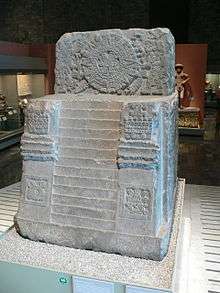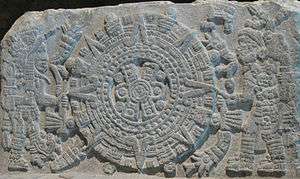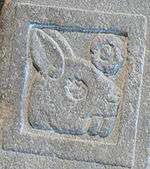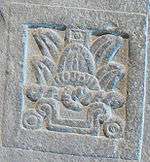Teocalli of the Sacred War

The Teocalli of the Sacred War (teocalli is Nahuatl for "temple"; Spanish: El Teocalli de la Guerra Sagrada) is the name given by archaeologist Alfonso Caso to a monolithic pre-Columbian miniature of an Aztec temple, thought by some to have served as a throne.
The sculpture was first discovered in 1831 in the foundations of the National Palace of Mexico, but was not removed until the 1920s. It is now located in the Museo Nacional de Antropología, Mexico City.
Reliefs
The upper part of the front of the sculpture contains a solar disk flanked by two figures; within the disk is the date Four Movement. The figures are identified as Huitzilopochtli (left) and Moctezuma II (right).

Below this, facing upwards, is a depiction of the earth deity Tlaltecuhtli, next to which are military equipment representing warfare.
The lower part of the front of the sculpture displays the dates One Rabbit (left) and Two Reed (right). The latter includes a rope representing the New Fire ceremony in that year.
 |
 |
On the sides are skeletal figures that may represent deities.
The top of the sculpture displays the date Two House.
The back of the sculpture depicts an eagle above a cactus, symbolizing of the foundation of Tenochtitlan.
Bibliography
- Caso, Alfonso (1927). El Teocalli de la Guerra Sagrada (Descripción y Estudio del Monolito Encontrado en los Cimientos del Palacio Nacional). Mexico: Talleres Graficos de la Nación.
External links
- Teocalli de la Guerra Sagrada on Flickr — the back of the sculpture
